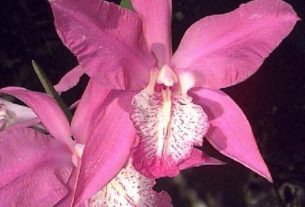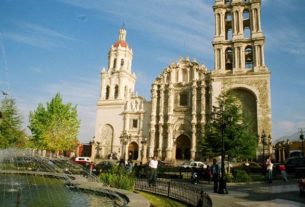From Cholula we are in the city of Puebla in a matter of minutes. Though Puebla is a city of maybe 1.5 million people, it is not a city of tall buildings of steel and glass. The old part of town surrounds the main plaza or ‘zocalo’. The plaza is dominated by a magnificent Cathedral and buildings dating back to the colonial era, with their portales. El Parian is an arts and crafts market, within walking distance of the plaza. It consists mostly of permanent stalls but there is an area provided for vendors who visit and sell their wares on blankets spread on the ground. This market is usually a very busy place. If you are from the US and want to feel more at home, there is a Sears store a block or so from the plaza, located in an old renovated building.
The city of Puebla was founded in 1531, eleven years after the Conquest, around 40 years after Columbus discovered the Americas. It is one of the oldest cities in the Americas founded by Europeans. It was originally named Puebla de los Angeles, after a Bishop’s vision of the town being built by angels. It was a city designed and built by Spaniards, for Spaniards. The Spaniards needed an outpost to control the powerful native groups of Tlaxcala, Cholula, Tepeaca, and Huejotzingo. It would be a place friendly to new settlers and for the Conquistadores. It would serve as a marketplace for native produce and as a means of controlling their economy. Finally, it would help secure passage between Mexico City and Veracruz, where goods were shipped to, and received from, Spain.
I’ve made a lot of trips to Puebla but still don’t know a lot about the city. I usually go there for a specific purpose and then turn around and come home. Most any tour guide book will devote ample space to the city.
Now we head south toward Atlixco, which is only a twenty or thirty minute drive. On the outskirts of Puebla, just before the toll road, is a Sam’s and, I believe, an Office Max. Atlixco boasts of having the most beautiful year round climate in the world. There are many nurseries and greenhouses in the area. The owner of one nursery has a large collection of bonsai trees. He is an engineer, but has studied the art of bonsai from Japanese masters, mostly in the US. He has also published a book on the cultivation and care of bonsai.
South of Atlixco is a concentration of families of Italian descent. They mostly farm, grow flowers, and make their own variety of cheeses. One dairy family, as a sideline, builds custom cars on VW chassis’.
Continuing south, off to the left, is something like a family weekend resort. A small, swift river rushes through tall thick trees. There is a restaurant, two pools with modern water slides, and a spacious area for picnicking and pitching tents.
A little further down the road is a village where Martin, whose first language is Nahuatl, serves as an area priest. I had the honor of attending his ordination some 10 years ago, at the Cathedral in Puebla.
Now we are driving through flat sugar cane country where we pass a Bacardi plant and arrive in Azucar de Matamoros. We are at the old crossroads to Oaxaca, which I suspect may date back to pre-Columbian times. In a remote area, not far away, is a village called San Juan Epetlan. Here, there is a hill which the villagers refer to as ‘the pyramid’. On exploring the hill I found remmnants of walls and platforms, interesting mineral samples and fragments of artefacts of obsidian, clay, and other stone. The hill reminded me of a war zone, pitted with holes where people had been digging. I think the government vaguely recognizes it as an archaeological site, but has done little to preserve or restore it.
I’ve acquired small items for my collection from people who live on the hillside. I even jokingly offered to help a lady finish excavating the site for her lot. There were a lot of obsidian and pieces of clay pottery visible in the embankment.
I became acquainted with an elderly man at the base of the hill, who seemed to occupy most of his time tending his sheep, digging for artefacts, and drinking homemade mescal. He had a small seated Olmec figurine which he offered to sell me. I knew the Olmec were in the area before the time of Christ. The price was very reasonable, but more than I felt I could spend. He wouldn’t budge. “If you want something cheap, go to the city and buy a fake.” That piece haunted me for about a month, and I finally went back and bought it.
Incidentally, I do not take national treasures out of the country, nor do I sell them. I figure I am just an unpaid custodian of the things I have collected. Besides, if all the artefacts in private hands were turned over to the government, they wouldn’t know where to store them.
From Azucar de Matamoros, we will head north, into “Zapata land”, in the next article.


